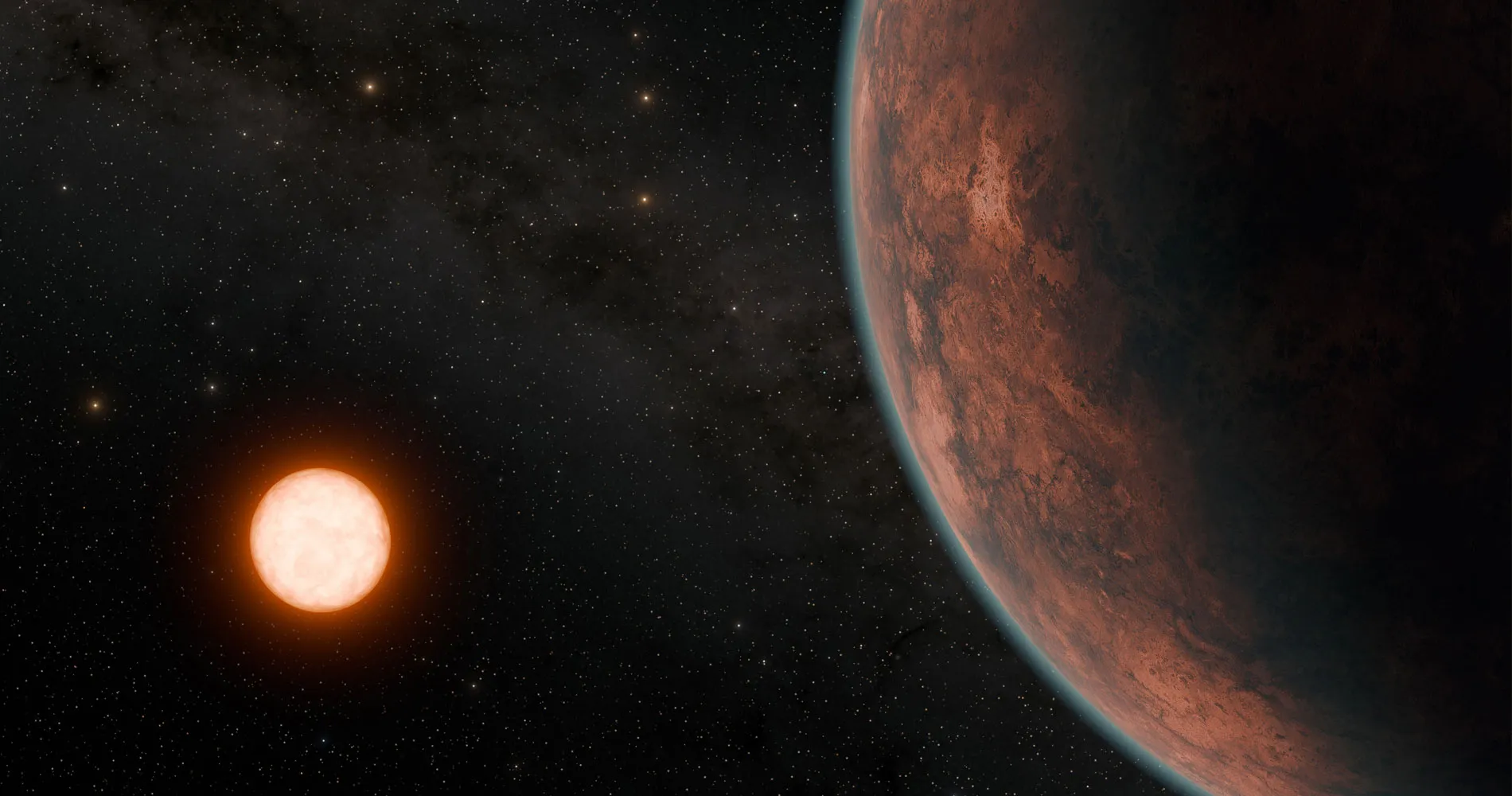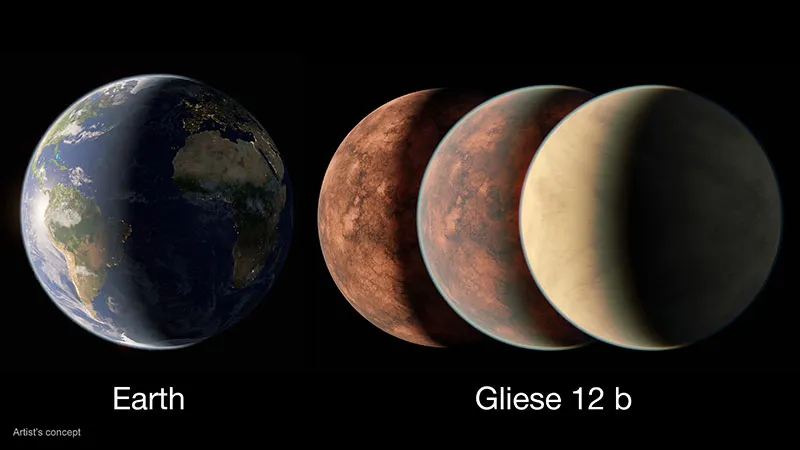In May 2024, NASA made an exciting announcement: scientists discovered Gliese 12b, an Earth-like planet located just 40 light-years away. With some possible similarities to Earth, including a potential atmosphere and the possibility of primitive life, it has sparked widespread speculation about its potential as a second home for humankind. However, while its discovery offers promising possibilities, there are still many challenges ahead.
Lukas Barcherini Peter
20 November 2024
Arabic version | French version | German version | Spanish version
Gliese 12b is an exoplanet—a planet that orbits a star outside our solar system. The search for exoplanets began in 1994. Since then, over 5000 exoplanets have been cataloged. Most of these planets differ greatly from Earth, with many being gas giants or frozen worlds that are hostile to life. However, a small fraction of those—among these Gliese 12b—are more like Earth and offer exciting opportunities for investigation and exploration.
Gliese 12b stands out because it is about 10% larger than Earth and orbits within its star’s “habitable zone ” – the region around a star where conditions are right for liquid water to exist – an essential ingredient for life and oxygen. The planet orbits an M-type dwarf star, the most common type of star in our galaxy. M-dwarfs are cooler and less bright than our Sun but much more radiatively volatile. Despite this, they allow planets like Gliese 12b to remain at temperatures that could support life, even though it orbits much closer to its star than Earth does to the Sun. In fact, Gliese 12b completes one orbit in roughly 13 days.
While NASA’s Transiting Exoplanet Survey Satellite (TESS) discovered these key characteristics, TESS can only detect a planet’s size and orbit. Therefore, more research is needed to understand whether Gliese 12b could support life.
This is where the James Webb Space Telescope (JWST) comes in. Unlike TESS, the JWST can analyze the planet’s atmosphere by identifying the “colour signature” of gases like oxygen, methane, or water vapor. This process, called atmospheric spectrometry, helps scientists determine the composition of a planet’s atmosphere and assess its habitability.
While JWST has not yet completed its observations of Gliese 12b, early findings indicate that its atmosphere might be far from ideal for supporting life. One of the major concerns is that Gliese 12b could be tidally locked, meaning one side constantly faces its star, while the other remains in darkness. This leads to stark differences that make it difficult for an atmosphere to regulate temperature and could destabilize the conditions required for life.
Gliese 12b’s estimated size may be as large as Earth or slightly smaller — comparable to Venus in our solar system. This artist’s concept compares Earth with different possible Gliese 12 b interpretations, from no atmosphere to a thick Venus-like one. Follow-up observations with NASA’s James Webb Space Telescope will help determine just how much atmosphere the planet retains as well as its composition. Illustration of Earth compared to various models of Gliese 12b. At left, against a black background, floats an artist’s concept of a nearly half-illuminated Earth, with clouds, blue oceans, and land areas rendered in green, tan, brown, and white. At right are three similarly illuminated planets, slightly smaller than Earth and each representing a possible interpretation of Gliese 12 b. The version on the left has a surface of blotchy reddish and brownish features and no atmosphere. The middle version has the same surface texture partly obscured by a hazy atmosphere. And the rightmost and smallest version of the planet has a thick, Venus-like atmosphere that obscures the surface completely. © NASA/JPL-Caltech/R. Hurt (Caltech-IPAC)
Based on the planet’s distance from its star, scientists initially estimated its average temperature could be around 40°C (104°F), theoretically allowing liquid water to exist. However, the extreme temperature differences, created by tidal locking, could disrupt the atmosphere. If the planet’s atmosphere behaves similarly to, for example, the known atmosphere of earth’s neighbor Venus, Gliese 12b would be uninhabitable.
Despite some assumed similarities in appearance, Venus and Gliese 12b might share more than just colour. Venus experiences a runaway greenhouse effect, where its thick atmosphere traps heat, causing temperatures high enough to melt lead. This happens because Venus receives more solar radiation than Earth, and its dense atmosphere prevents the heat from escaping.
Gliese 12b could experience similar conditions, especially on the side facing the star, which would make it unlikely to support life. Another possibility is that the planet could have a thin, Earth-like atmosphere or even no atmosphere at all. However, a more likely too-thin atmosphere would not provide enough air pressure for liquid water to exist. Even if the atmosphere is not as toxic as Venus’s, life on Gliese 12b might still be impossible. For example, the Moon has virtually no atmosphere (roughly one quadrillionth of earth’s atmospheric air pressure), and despite extreme temperatures of up to 120°C (248°F) near the equator of the moon, the ice on it still does not melt.
Regardless of these significant possible challenges, Gliese 12b remains an invaluable discovery. The planet offers a rare opportunity to study a world that, while unlikely to become humanity’s “second home,” holds critical insights into the complex processes that govern planet formation, evolution, and the development of atmospheres.
Even though the possibility of life on Gliese 12b seems increasingly remote, the research conducted on this exoplanet deepens our understanding of what makes a planet habitable and what factors may prevent it. These findings also refine the criteria used by scientists to identify other potentially habitable planets, providing valuable data for future exploration. Since Gliese orbits an M-type dwarf star, this study lays the groundwork for examining other exoplanets in the habitable zone of its star that will likely be discovered in the years to come.
Ultimately, the ongoing study of Gliese 12b, while offering no immediate answers about our place in the universe, brings us one small, but crucial, step closer to resolving the age-old question: Are we alone? Even in the face of challenges, Gliese 12b will likely remain a key for humanity’s quest to understand the cosmos and to find life beyond our own world.








